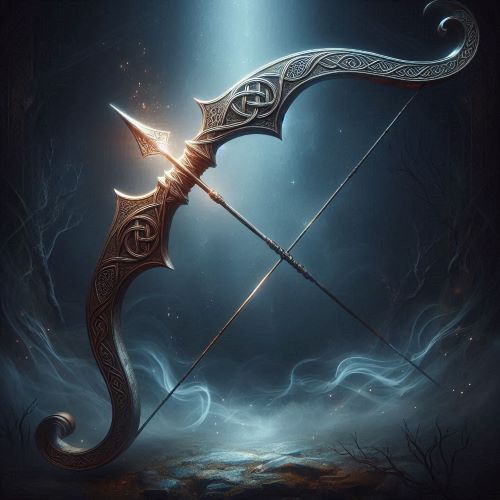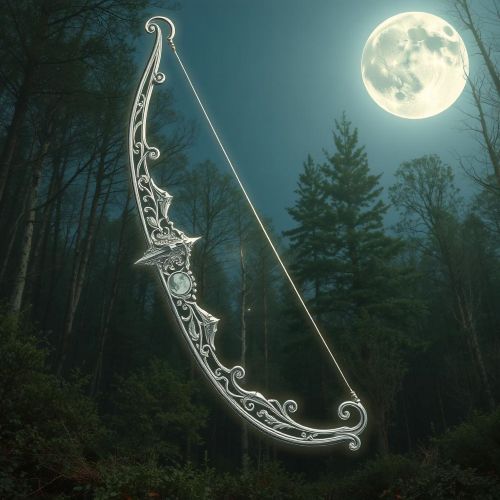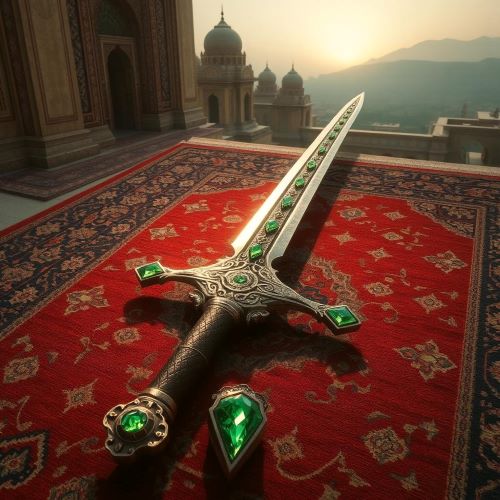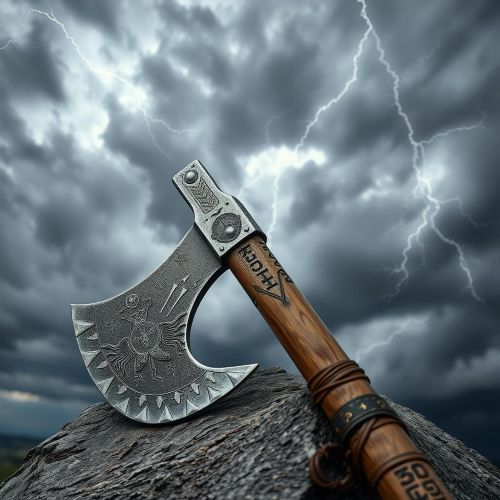Tishtrya’s Bow : The Rain Maker
Tishtrya’s Bow
Introduction
In Zoroastrian mythology, Tishtrya is one of the most radiant and vital deities, associated with rainfall, fertility, and the cosmic balance that sustains life. Known in Middle Persian as Tir and linked to the brilliant star Sirius, he is celebrated for his role in defeating the demon of drought and restoring abundance to the earth. Among the symbols tied to his power, none is more evocative than Tishtrya’s Bow, a celestial weapon often imagined as the rainbow or the Milky Way arcing across the heavens. This divine bow is not just a tool of warfare but a manifestation of cosmic order, carrying within it the promise of rain, fertility, and spiritual renewal.
Origins
The roots of Tishtrya’s Bow are deeply embedded in the Avesta, particularly the Tir Yasht, which honors the deity’s struggle against Apaosha, the embodiment of drought. While the bow itself is not described as a physical artifact, its symbolism draws from layers of linguistic, cultural, and cosmological associations. The very name Tir translates to “arrow” in Persian, creating an inherent connection between Tishtrya and archery. This linguistic link echoes across ancient cultures—Babylonian and Sumerian hymns even describe Sirius, the star tied to Tishtrya, as the “Arrow Star,” reinforcing his celestial role as a divine archer.
The bow’s imagined form is cosmic in scale. Some traditions identify it with the rainbow, a divine sign of rain’s arrival, while others see it as the Milky Way, a heavenly arc of stars guiding the rhythms of nature. Its seasonal significance is emphasized during the Tirgan Festival in July, a time when prayers to Tishtrya ensure rainfall and renewal. This weapon, born of light and divine alignment, symbolizes a bridge between heaven and earth, a conduit through which order triumphs over chaos.
Think you know your myths and legends? Dive into the world of ancient stories and test your knowledge with our engaging quizzes on Mythlok!
Powers
Tishtrya’s Bow represents more than martial strength—it embodies the elemental forces of creation and restoration. With it, Tishtrya channels the energy of the stars to break the grip of drought. In Zoroastrian lore, the bow becomes a tool of invocation, summoning life-giving rains when the earth is parched. Its arrows are not made of wood or metal but of pure light, imagined as shafts that pierce through clouds of chaos and release rivers of water onto the earth.
The bow’s power also extends to cosmic combat. In myth, Tishtrya faces Apaosha in a battle that determines whether drought or abundance will prevail. The bow allows him to strike decisively, reminding devotees that divine justice ensures balance in the natural world. Beyond the battlefield, the bow carries purifying energy, cleansing the heavens of demonic influence and restoring harmony to creation. Its arc, reflected in the rainbow or starry sky, signifies renewal and balance between the spiritual and material worlds.
Owners/Users
Unlike many mythological weapons that pass from hand to hand, Tishtrya’s Bow is inseparable from the deity himself. It is a manifestation of his celestial essence rather than a separate artifact. Empowered by Ahura Mazda, the supreme god of Zoroastrianism, Tishtrya alone wields the bow to fulfill his role as guardian of rainfall and fertility.
Although no other deity is depicted using this bow directly, its symbolic resonance is shared with other figures of light and justice. Mithra, the solar god associated with truth and contracts, and Hvare-khshaeta, the sun deity who embodies brilliance, are often seen as spiritual allies in Tishtrya’s struggle. Together, they uphold cosmic order, their roles interwoven with the celestial imagery of the bow and arrow. In this way, the bow becomes more than a personal weapon—it reflects a collective effort by the divine to safeguard life and ensure prosperity.
Instances used
The most dramatic tale involving Tishtrya’s Bow is found in the Tir Yasht, where the god engages in a cosmic duel with Apaosha, the demon of drought. Tishtrya takes the form of a radiant white horse, while Apaosha appears as a black horse, embodying the darkness of famine. Armed with his divine bow, Tishtrya shoots arrows of light that shatter the demon’s strength, allowing rain to pour freely over the earth. This myth highlights the bow as the ultimate weapon of renewal, a divine guarantee that abundance will follow hardship.
The bow’s imagery is also reflected in seasonal rituals. During the Tirgan Festival, prayers, water rituals, and the symbolism of the rainbow evoke Tishtrya’s victory, reminding communities of the ongoing relationship between humanity, the divine, and the natural cycles of rain and growth. In this context, the bow is not confined to the mythic past but remains alive in cultural memory, a celestial promise seen in every rainbow after a storm.
In broader cultural parallels, the bow’s symbolism recalls other Iranian legends, such as that of Arash the Archer, whose arrow established the boundaries of Persia. Just as Arash’s arrow defined the land, Tishtrya’s Bow ensures its fertility and survival, uniting themes of protection, justice, and cosmic order.
Frequently Asked Questions
Lorem ipsum dolor sit amet, consectetur adipiscing?
Lorem ipsum dolor sit amet, consectetur adipiscing elit. Praesent convallis vestibulum justo, ac tincidunt nunc vehicula quis. Nullam id dolor quis orci malesuada feugiat. Curabitur aliquet libero at urna ullamcorper, ac ultricies nulla dapibus.
Lorem ipsum dolor sit amet, consectetur adipiscing?
Lorem ipsum dolor sit amet, consectetur adipiscing elit. Praesent convallis vestibulum justo, ac tincidunt nunc vehicula quis. Nullam id dolor quis orci malesuada feugiat. Curabitur aliquet libero at urna ullamcorper, ac ultricies nulla dapibus.
Lorem ipsum dolor sit amet, consectetur adipiscing?
Lorem ipsum dolor sit amet, consectetur adipiscing elit. Praesent convallis vestibulum justo, ac tincidunt nunc vehicula quis. Nullam id dolor quis orci malesuada feugiat. Curabitur aliquet libero at urna ullamcorper, ac ultricies nulla dapibus.
Lorem ipsum dolor sit amet, consectetur adipiscing?
Lorem ipsum dolor sit amet, consectetur adipiscing elit. Praesent convallis vestibulum justo, ac tincidunt nunc vehicula quis. Nullam id dolor quis orci malesuada feugiat. Curabitur aliquet libero at urna ullamcorper, ac ultricies nulla dapibus.
Lorem ipsum dolor sit amet, consectetur adipiscing?
Lorem ipsum dolor sit amet, consectetur adipiscing elit. Praesent convallis vestibulum justo, ac tincidunt nunc vehicula quis. Nullam id dolor quis orci malesuada feugiat. Curabitur aliquet libero at urna ullamcorper, ac ultricies nulla dapibus.
Watch
Source
Wikipedia contributors. (n.d.). Tishtrya. Wikipedia. Retrieved August 22, 2025, from https://en.wikipedia.org/wiki/Tishtrya
Boyce, M. (1999). Tistrya. In Encyclopaedia Iranica. Retrieved August 22, 2025, from https://iranicaonline.org/articles/tistrya-2
Darmesteter, J. (Trans.). (1883). Tir Yasht (Yasht 8). In Sacred Books of the East, Vol. 23. Avesta.org. Retrieved August 22, 2025, from https://www.avesta.org/ka/yt8sbe.htm
Wright, J. (2021, July 12). Twelve gods of Persian mythology. World History Encyclopedia. Retrieved August 22, 2025, from https://www.worldhistory.org/article/1486/twelve-gods-of-persian-mythology/
Kamboozal. (n.d.). Tishtrya. Kamboozal Mythology Archive. Retrieved August 22, 2025, from https://www.kamboozal.com/deities-16/tishtrya
Symbolikon. (n.d.). Tishtrya (Tishtar) – Persian symbol. Symbolikon Zoroastrian Collection. Retrieved August 22, 2025, from https://symbolikon.com/downloads/tishtrya-tishtar-persian/









